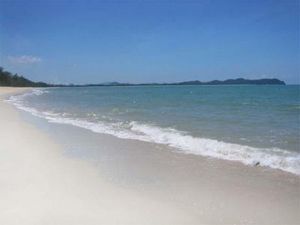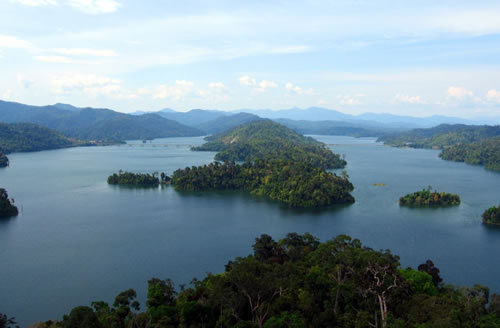17-November-2006

At least once a year, my whole family would take a drive to Kuala Terengganu to see my Grandma who lives in Marang. The drive, which spans eight-hours is usually a whole’s day trip already.
For the most part, Marang is quite old school. Although it still resembles a kampung, much of it has been renovated. Houses there used to have nipah roofs. Now, half the houses have been refurbished with bricks and concrete. There is nothing much here, but sometimes you really need this sort of escape. Life is simple, people are friendly and the roadsides are lines with little stalls selling keropok lekor and dodol.
I fondly recall a trip we took not too long ago. We were already in Kuala Terengganu when my family and cousins decided at the last minute to take a trip to Kapas Island. It was totally unplanned. We just walked over to the jetty and enquired the boat schedule, and that was it.
We left early in the morning. There are two kinds of boat that goes to Kapas Island, a speed boat and a normal boat. We were on the normal boat. The boat ride took about 45 minutes. At first, I was not really used to being on a boat. But surrounded by my family really helps.
We checked into a beachside resort quite early on Kapas Island, and went straight for snorkelling. You got to be early to go snorkelling. We were provided life jackets, snorkel masks and flippers. The water was cool and the sun was warm. This was my very first snorkelling experience and it was really fun.
Someone told us that if we wanted the fish to come to us, we should bring bread to feed the fish with. It was really fun to see the fish swimming up to us. Even my mum, who did not snorkel, waded into the water halfway, just to feed the fish. Two hours went by really quickly.
We spent the afternoon and evening going on long walks by the beach. I felt so peaceful, relieved and glad that I got to spend some quality time with my family. We passed by people playing volleyball. It was just so relaxing.
We were supposed to have a bonfire that night, but it rained, so we spent the better part of the night just hanging out at the resort’s restaurant chatting and drinking coffee. The thing about this place is that the people are helpful and friendly. If you need anything, there are willing to help you.
We returned to Kuala Terengganu the next morning. Kuala Terengganu has its own charms, actually. There is a huge pasar in town that sells everything from vegetables, to batiks and dodols. Everything is just so fresh. I have no idea when the pasar starts, but when we went there in the afternoon, it was already open. You can get practically everything here, stuff are cheap and you can bargain with the sellers. The traders will try to give a good price most of the time.
I bought quite a lot of things, some batik for my aunty, a doll pillow and keychains.
We spent five days in Terengganu. It was nice and certainly a trip where I could take my mind off everthing except enjoy, relax and have fun. Everyone in my family seemed crazy during the trip, but that makes the whole experience fun. Between long drives from KL, to last minutes plans to go to Kapas Island, to having a blast at the pasar in Kuala Terengganu, it really was a good break for me.
It felt good to come back to town and face the music after all that. I wish I could go to Kapas Island again!
Source/See more : http://www.virtualmalaysia.com/community/travel_experience/













